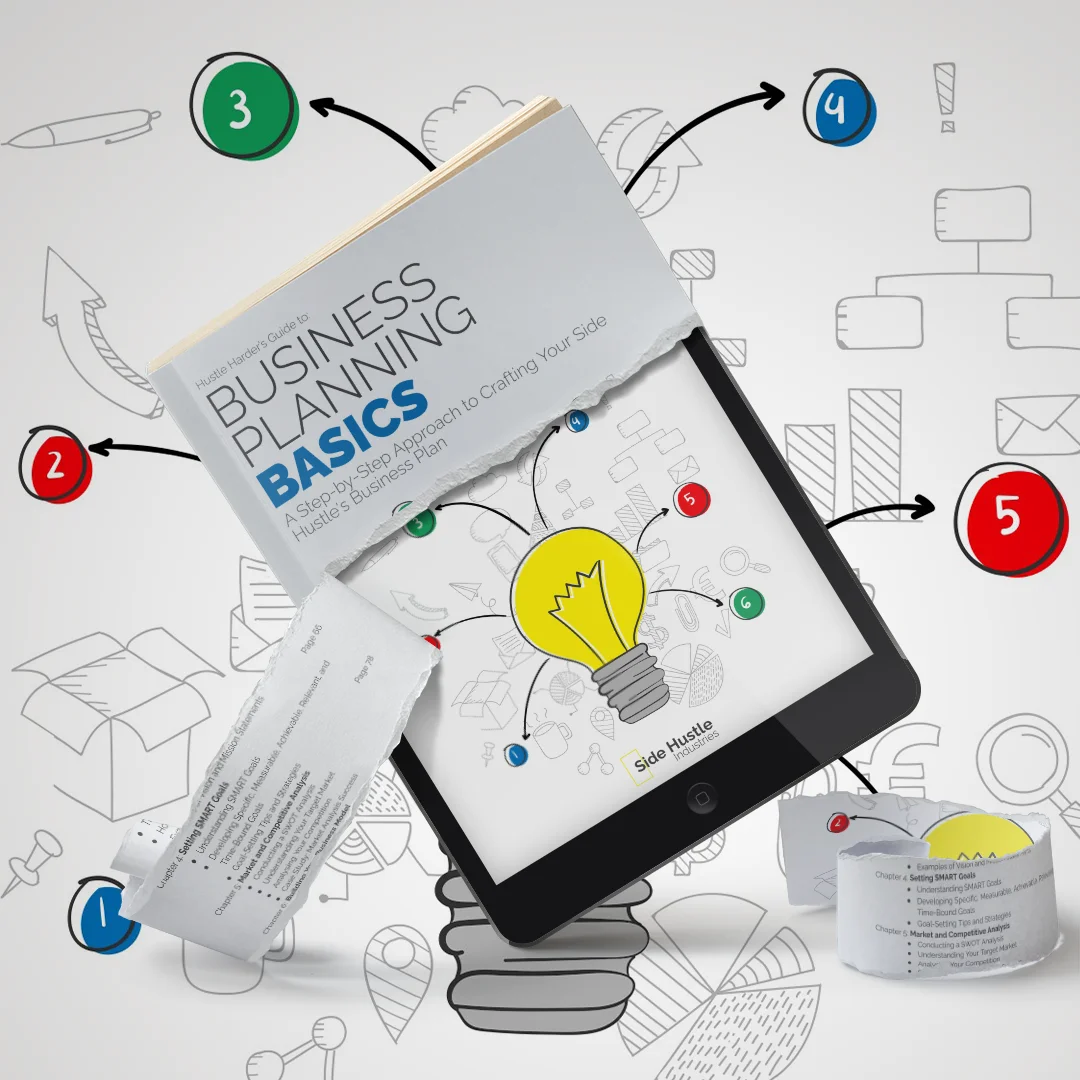
In the dynamic world of entrepreneurship, understanding your side hustle’s internal strengths and weaknesses, as well as the external opportunities and threats it faces, is crucial for informed decision-making and strategic planning. One valuable tool for this purpose is the SWOT analysis. SWOT stands for Strengths, Weaknesses, Opportunities, and Threats, and it offers a structured way to evaluate your business and its competitive environment. In this blog, we’ll delve into how to conduct a SWOT analysis effectively, providing insights into each component of this comprehensive assessment.
Understanding SWOT Analysis
A SWOT analysis is a strategic planning tool used to assess the internal and external factors that can impact your business. By evaluating these factors, you gain a clearer understanding of your business’s current position and its potential to succeed in the market. Let’s break down each component of the SWOT analysis:
1. Strengths (S):
Strengths represent the internal, positive attributes and resources that your business possesses. These are the factors that set your business apart and give it a competitive advantage. Identifying your strengths helps you capitalise on what you do well.
Examples of business strengths can include a strong brand reputation, proprietary technology, skilled workforce, efficient processes, or loyal customer base.
2. Weaknesses (W):
Weaknesses are internal factors that hinder your business’s performance or limit its growth potential. Identifying weaknesses is essential for addressing areas that need improvement and preventing potential setbacks.
Weaknesses may encompass outdated technology, a lack of marketing strategy, high employee turnover, or limited financial resources.
3. Opportunities (O):
Opportunities represent external factors and market conditions that your business can leverage to its advantage. These are external situations or trends that your business can exploit for growth and success.
Opportunities might include emerging markets, new consumer trends, changes in regulations that favour your industry, or advancements in technology that can enhance your products or services.
4. Threats (T):
Threats are external factors that can potentially harm your business or pose challenges. Identifying threats allows you to prepare for potential risks and develop strategies to mitigate or avoid negative impacts.
Threats can include competition from larger corporations, economic downturns, changing consumer preferences, or unforeseen industry regulations.

How to Conduct a SWOT Analysis
Conducting a SWOT analysis involves a systematic evaluation of each of the four components. Here’s a step-by-step guide to conducting a SWOT analysis for your business:
1. Gather a Diverse Team:
Invite team members from various departments and levels within your organisation to provide different perspectives and insights. The more diverse the team, the more comprehensive your SWOT analysis will be.
2. Identify Your Strengths (S):
Begin by examining your business’s internal strengths. Ask questions like:
- What advantages do we have over our competitors?
- What resources and assets are at our disposal?
- What unique skills or expertise do we possess?
- What is our market reputation or brand recognition?
Compile a list of all identified strengths. It’s crucial to be objective and honest during this process, focusing on tangible and quantifiable attributes.
3. Identify Your Weaknesses (W):
Next, turn your attention to your internal weaknesses. Consider the following questions:
- Where do we fall short compared to our competitors?
- What aspects of our business operations need improvement?
- Are there resource constraints or skill gaps?
- Are there recurring issues that hinder our productivity or performance?
Again, compile a comprehensive list of identified weaknesses. Acknowledging and addressing these shortcomings is the first step toward improvement.
4. Identify Opportunities (O):
Shift your focus to external opportunities. Explore your business environment and market trends, asking:
- What new trends or technologies could benefit our business?
- Are there unexplored market segments or emerging customer needs?
- Have there been regulatory changes that create favourable conditions?
- Are there gaps in the market that we could fill with our products or services?
List all identified opportunities. These can serve as potential pathways for growth and expansion.
5. Identify Threats (T):
Finally, examine external threats that could impact your business negatively. Consider:
- Who are our major competitors, and what strategies are they using?
- Are there economic or industry trends that pose risks?
- Are there potential obstacles created by regulations or political changes?
- Are there vulnerabilities in our supply chain or partnerships?
List all identified threats. Recognizing and understanding these risks enables you to prepare for and mitigate potential challenges.
6. Analyse and Prioritise:
After compiling your lists of strengths, weaknesses, opportunities, and threats, analyse and prioritise them. Determine which factors are most significant and relevant to your business. You can use a scoring system to assign weight to each factor and assess their relative importance.
7. Develop Strategies:
With a clear understanding of your SWOT analysis, you can now develop strategies to capitalise on your strengths, address your weaknesses, leverage opportunities, and mitigate threats. These strategies can inform your business planning and decision-making.
For example, if your SWOT analysis reveals that a major opportunity lies in expanding into an emerging market, you can develop a strategy to allocate resources and enter that market effectively.
8. Periodic Review and Update:
A SWOT analysis is not a one-time process but a dynamic tool that should be periodically reviewed and updated. As your business evolves and market conditions change, your SWOT analysis should reflect these shifts. Regularly revisit your SWOT analysis to ensure its relevance and effectiveness.
Real-Life Example of a SWOT Analysis
Let’s consider a real-life example of a SWOT analysis for a small e-commerce business:
Strengths (S):
- Strong online presence with a well-established website and active social media.
- Unique product offerings, including eco-friendly and handmade items.
- A loyal customer base with a high customer retention rate.
Weaknesses (W):
- Limited financial resources for marketing and expansion.
- Dependence on a single supplier for certain products.
- Challenges with supply chain efficiency and inventory management.
Opportunities (O):
- Growing consumer interest in eco-friendly products.
- Expanding into international markets through e-commerce.
- Partnering with local artisans and expanding product range.
Threats (T):
- Intense competition from larger e-commerce platforms.
- Fluctuations in exchange rates impacting international sales.
- Shifting consumer preferences and market trends.
This SWOT analysis helps the e-commerce business understand its strengths, weaknesses, opportunities, and threats in the context of its industry and market. It serves as a foundation for developing strategies to leverage strengths, mitigate weaknesses, capitalise on opportunities, and prepare for potential threats.

Using SWOT Analysis in Your Business Planning
The insights gained from a SWOT analysis can be invaluable in shaping your business strategy, marketing plans, financial decisions, and more. Here’s how you can incorporate SWOT analysis into your business planning:
- Strategic Planning: Use the analysis to inform your overall business strategy. Consider how you can leverage your strengths to exploit opportunities, address weaknesses, and mitigate threats.
- Marketing Strategy: Develop marketing campaigns that align with your strengths and opportunities while addressing weaknesses and potential threats.
- Product Development: Tailor your product offerings to align with market trends and customer demands while considering your internal strengths and weaknesses.
- Financial Planning: Allocate resources based on your SWOT analysis. Invest in areas that enhance your strengths and capitalise on opportunities.
- Risk Management: Develop risk mitigation strategies for identified threats to minimise potential adverse impacts on your business.
By regularly revisiting and updating your SWOT analysis, you can adapt to changing market conditions, ensuring that your business remains agile and responsive to new challenges and opportunities.
Incorporating a SWOT analysis into your business planning allows you to make informed decisions that capitalise on your strengths, mitigate your weaknesses, leverage opportunities, and prepare for potential threats. It’s a valuable tool for both established entrepreneurs and those just starting on their business journey, providing a holistic view of the internal and external factors that shape your business’s success.

*Also available on Amazon in Kindle, Soft Cover & Hard Cover formats. —> Click Here.
